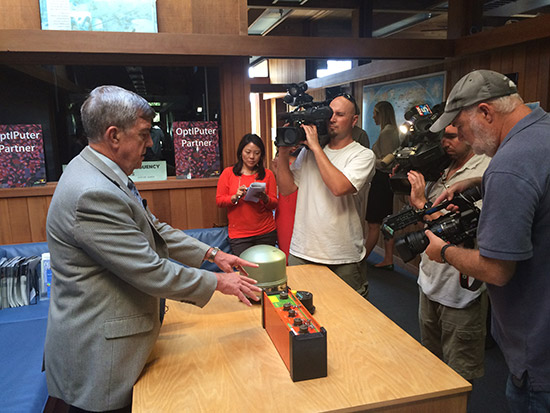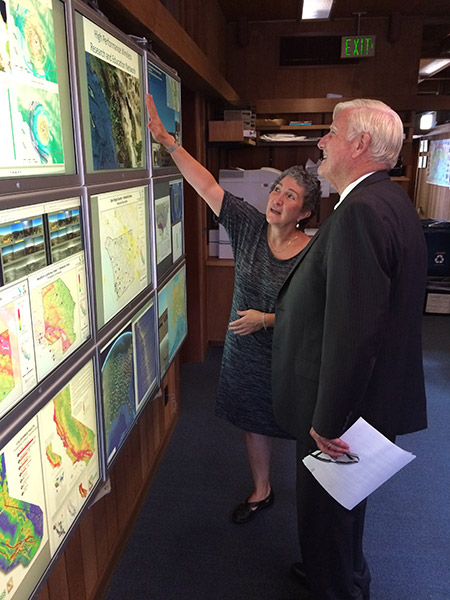Supervisor Cox, Scripps Scientists, Call for Continuation of Vital Earthquake Monitoring Programs
Networks provide critical data in high-risk region
Published Date
By:
- Mario Aguilera
Share This:
Article Content

John Orcutt, a distinguished geophysics professor at Scripps Institution of Oceanography at UC San Diego, describes seismic instrumentation used in the Scripps ANZA Seismic Network.
Scripps Institution of Oceanography at UC San Diego scientists joined San Diego County Supervisor Greg Cox on Oct. 28, 2014, in a call to sustain funding for earthquake monitoring projects designed to provide critical information for the region.
U.S. Geological Survey (USGS) cuts jeopardize the Scripps-operated ANZA Seismic Network, a system of 29 seismic sensors in San Diego, Riverside, and Imperial counties that transmits data continuously in real time, and the Precision Geodetic Network, which uses high-precision instruments to monitor the buildup of fault stress that leads to earthquake activity.
At a news conference describing the importance of the earthquake monitoring networks and impact of the cuts, Cox, along with Scripps distinguished geophysics professor John Orcutt and Scripps seismologist Luciana Astiz, highlighted the potential dangers of scaling back on earthquake monitoring networks.

At an Oct. 28, 2014, news conference, Scripps Institution of Oceanography at UC San Diego seismologist Luciana Astiz describes the Scripps ANZA Seismic Network to San Diego County Supervisor Greg Cox.
“Preserving federal funding for these Scripps networks is critical,” said Cox. “The loss of these networks would harm our ability to prepare and plan for major earthquakes in San Diego County. We should be expanding our seismic monitoring capabilities and providing for early warning notification systems.”
In 2013, California Senator Alex Padilla laid the groundwork for a statewide earthquake early warning system with Senate Bill 135 which requires the Office of Emergency Services to develop a comprehensive statewide earthquake early warning system to alert Californians in advance of dangerous shaking. Supervisor Cox pledged support for ongoing efforts to implement the system in San Diego.
“Preparing our communities for earthquakes makes sense both from a financial and safety aspect,” said U.S. 52nd District Representative Scott Peters in a statement of support. “I continue to support the USGS Earthquake Hazards program, which funds these UC San Diego Scripps Institution of Oceanography programs, to help mitigate damage from these disasters and to help save lives. For every dollar spent on preparedness and resiliency we save four dollars on recovery.”

At a Oct. 28, 2014, news conference at Scripps Institution of Oceanography at UC San Diego, San Diego County Supervisor Greg Cox urged support of the Scripps ANZA Seismic Network.
Seismologist Astiz noted during the briefing that San Diego County is susceptible to earthquakes occurring at three major faults in Southern California: the San Andreas, San Jacinto, and Elsinore faults. These three faults have been identified by the USGS as having increased probability of rupturing with earthquakes of magnitude 6.7 or higher in the next 30 years. Due to their location on and near faults, loss of ANZA seismic sensors may decrease the warning time San Diego County’s three million residents could receive.
Orcutt, a researcher with the Cecil H. and Ida M. Green Institute of Geophysics and Planetary Physics at Scripps, noted that beyond providing vital earthquake data, the ANZA network uses the HPWREN communications infrastructure that also serves in transmitting information about hazards such as wildfires to first responders.
At Cox’s urging, the County Board of Supervisors earlier Tuesday voted unanimously to seek continued federal funding for the Scripps programs and to support development of earthquake early warning.
Share This:
You May Also Like
Stay in the Know
Keep up with all the latest from UC San Diego. Subscribe to the newsletter today.



